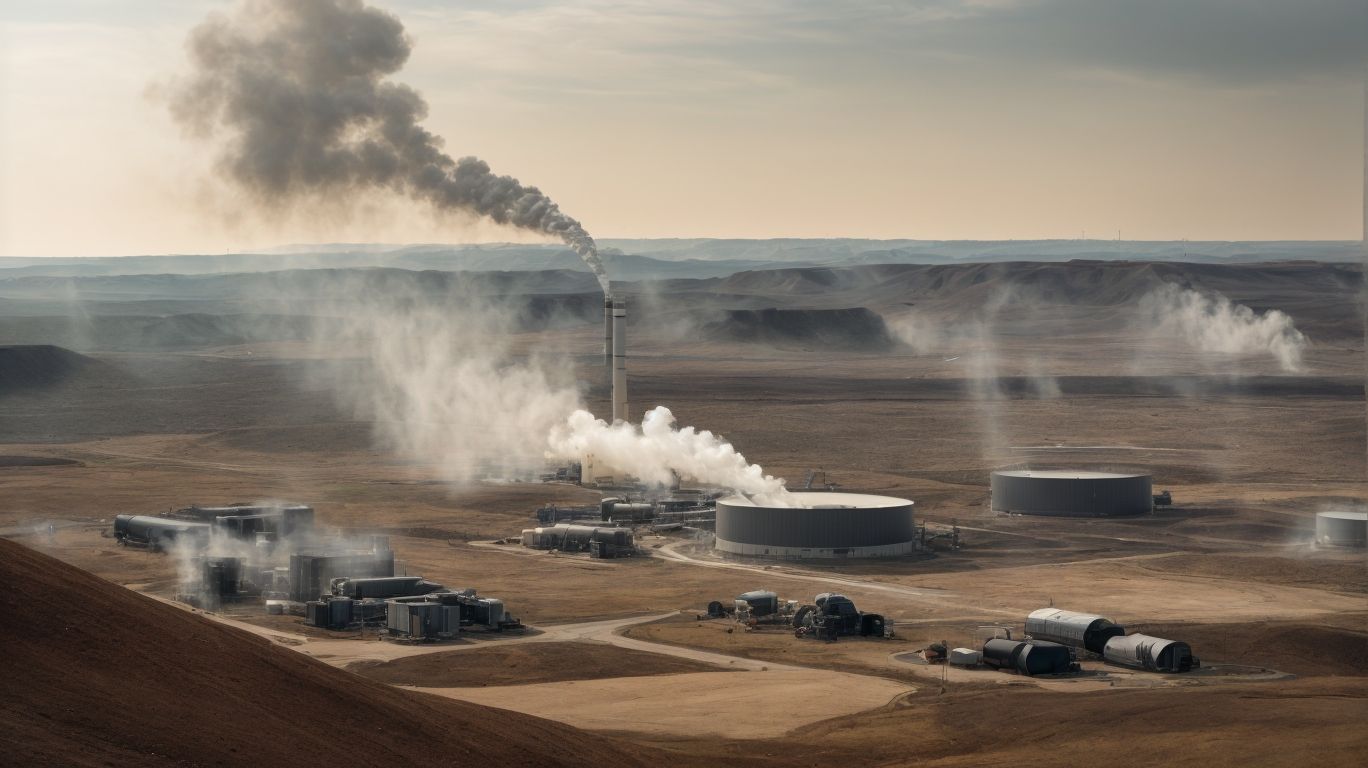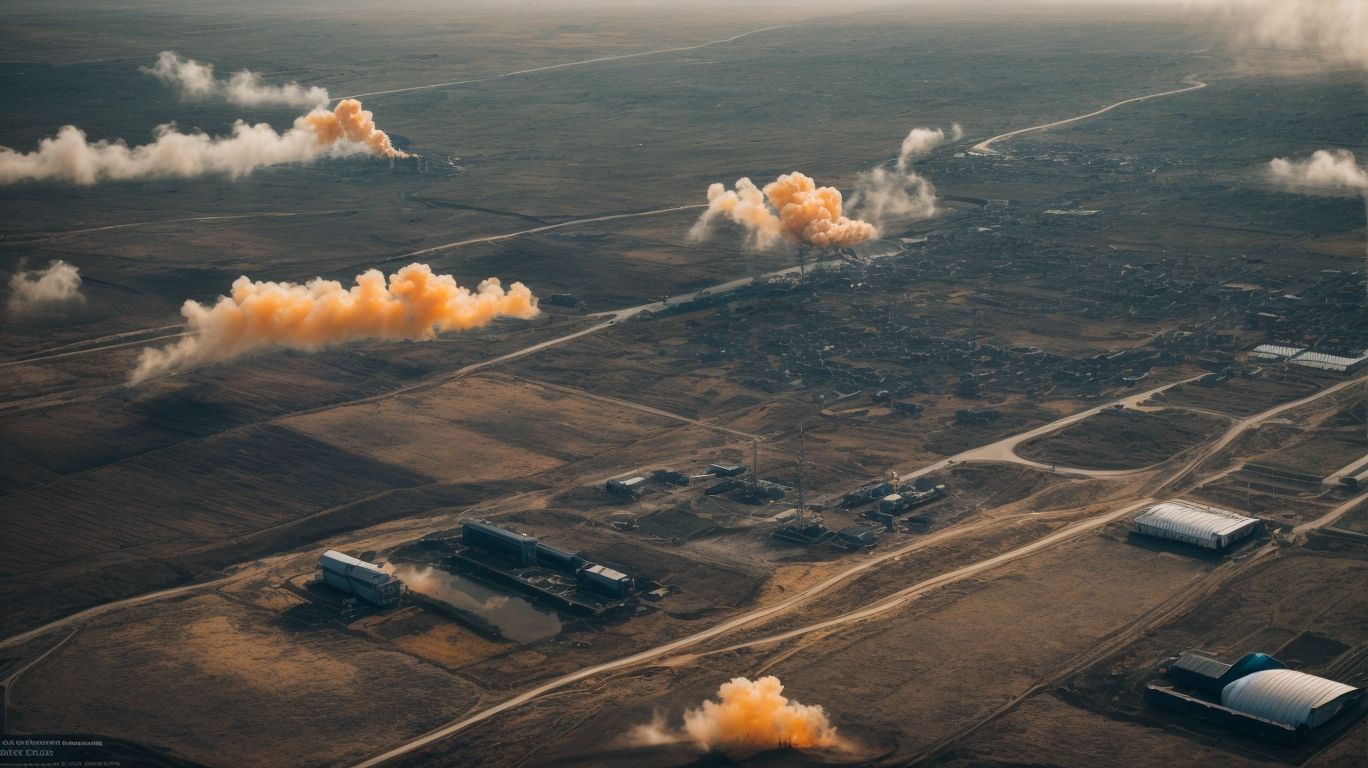Methane is a colorless, odorless, and flammable gas that is found naturally in the atmosphere. It is the primary component of natural gas and is also a potent greenhouse gas with a global warming potential 28 times higher than carbon dioxide over a 100-year period. Understanding the sources and sinks of methane is crucial in addressing its impact on climate change.
Natural sources of methane account for approximately 40% of total methane emissions, while human-related sources make up the remaining 60%. Some natural sources of methane include:
- Wetlands: Wetlands, such as swamps and marshes, are the largest natural source of methane, producing approximately 30% of total emissions. This is due to the anaerobic conditions in these environments, which create ideal conditions for methane-producing microbes.
- Termites: Termites digest cellulose, a component of wood, and produce methane as a byproduct. It is estimated that termites contribute to about 2% of global methane emissions.
- Oceans: The oceans are a significant source of methane, with the majority of emissions coming from the continental shelves. Methane is released into the atmosphere when microorganisms break down organic matter in the water.
- Landfills: As waste decomposes in landfills, methane is produced. Landfills are responsible for about 18% of total methane emissions globally.
Human-related sources of methane include:
- Agriculture: Methane is produced by livestock during digestion and is also emitted from manure management. Agriculture accounts for approximately 30% of total methane emissions.
- Fossil Fuel Extraction and Use: Methane is released during the extraction and burning of fossil fuels, such as natural gas, coal, and oil. This accounts for approximately 14% of total methane emissions.
- Waste Management: In addition to landfills, methane is also produced from wastewater treatment and solid waste incineration.
Methane has both sources and sinks, which are processes that remove it from the atmosphere. Some of these sinks include:
- Chemical Reactions in the Atmosphere: Methane is oxidized in the atmosphere by hydroxyl radicals, which helps reduce its concentration.
- Soil Microbes: Methane can be consumed by microbes in the soil before it is released into the atmosphere.
- Ocean Absorption: The oceans act as a sink for methane, with some being consumed by marine microbes, and the rest being absorbed into the water.
The increase in methane concentration in the atmosphere has been linked to human activities, mainly from agriculture and fossil fuel use. Methane contributes significantly to climate change, trapping heat in the atmosphere and contributing to the Earth’s warming. In response, efforts are being made to reduce methane emissions, such as:
- Methane Capture and Use: Methane can be captured from landfills, animal manure, and energy production facilities and used as a fuel source.
- Methane Oxidation: Techniques are being developed to encourage the uptake of methane by soil microbes.
- Regulations and Policies: Governments are implementing regulations and policies to reduce methane emissions from various sources, such as the Oil and Gas Methane Partnership and the Global Methane Initiative.
By understanding the sources and sinks of methane, we can work towards reducing its impact on climate change and creating a more sustainable future.
Key Takeaways:
What Is Methane?

Photo Credits: Chemicalglossary.Net by Gabriel Hill
Methane is a powerful greenhouse gas that is created through both natural and human activities. Its chemical formula is CH4, and it is composed of one carbon atom and four hydrogen atoms. Despite being colorless and odorless, methane is a crucial component of natural gas and is released during the production and transportation of coal, oil, and natural gas. Additionally, livestock, such as cows and sheep, produce methane through their digestive processes. Due to its high heat-trapping abilities, methane is a major contributor to global warming, even more so than carbon dioxide.
What Are the Natural Sources of Methane?

Photo Credits: Chemicalglossary.Net by Harold Taylor
Methane is a powerful greenhouse gas that plays a significant role in global climate change. While it is most commonly associated with human activities such as agriculture and fossil fuel production, there are also natural sources of methane that contribute to its presence in the atmosphere. In this section, we will explore the various natural sources of methane, including wetlands, termites, oceans, and landfills. By understanding the origins of methane, we can gain a better understanding of its impact on our environment.
1. Wetlands
Wetlands are crucial natural sources of methane, contributing to the greenhouse effect and climate change. Here are the steps involved in the process of methane emission from wetlands:
- Waterlogged soil in wetlands creates oxygen-limited conditions.
- Decomposition of organic matter by microbes in the absence of oxygen produces methane.
- Methane is released into the atmosphere through the plants’ aeration system, known as aerenchyma.
- The amount of methane emitted depends on various factors such as temperature, nutrient availability, and plant species.
- Wetlands cover approximately 6% of the Earth’s land surface and account for around 20% of global methane emissions.
True story: A study conducted in the Everglades National Park revealed that elevated water levels and increased nutrients led to higher methane emissions from wetlands, highlighting the vulnerability of wetland ecosystems to environmental changes.
2. Termites
Termites are a natural source of methane emissions. These small insects produce methane as a byproduct of their digestive process. As termites consume wood, microorganisms in their gut help break it down and release methane gas. Globally, termites are responsible for a significant amount of methane emissions. It is estimated that termites contribute approximately 20% of the total methane emissions from natural sources. Therefore, understanding the role of termites in methane production is essential for accurately assessing and mitigating greenhouse gas emissions.
3. Oceans
Oceans are a crucial natural source of methane, contributing to greenhouse gas emissions. Here is a list of steps explaining the role of oceans in methane production:
- Marine microorganisms in sediments and water produce methane through biological processes.
- Seafloor methane seeps release large amounts of methane into the water column.
- Warming ocean temperatures can accelerate the release of methane, as it is stored in frozen hydrates in the sediments.
The discovery of underwater methane vents in the 1980s revolutionized our understanding of methane sources. Scientists exploring the depths of the oceans found these vents, which had previously gone unnoticed, shedding light on the significant role that oceans play in the production and emission of methane.
4. Landfills
Landfills are a significant source of methane emissions, contributing to climate change. To reduce these emissions, various steps can be taken:
- Capture and control systems: Landfills can install gas collection systems to capture methane released during waste decomposition.
- Landfill gas utilization: Instead of allowing methane to escape into the atmosphere, it can be collected and used as an energy source for electricity generation or heating.
- Improved waste management practices: Proper waste segregation and recycling can reduce the amount of organic waste sent to landfills, minimizing methane production.
- Methane oxidation: Techniques like biofilters or oxidation trenches can be used to enhance the natural process of methane breakdown in the landfill.
- Regulations and monitoring: Governments can implement regulations to enforce proper landfill management and monitor methane emissions to ensure compliance.
What Are the Human-Related Sources of Methane?

Photo Credits: Chemicalglossary.Net by Larry Perez
Methane, a potent greenhouse gas, is a major contributor to climate change. While methane exists naturally in the environment, human activities also play a significant role in its release into the atmosphere. In this section, we will delve into the various human-related sources of methane, including agriculture, fossil fuel extraction and use, and waste management. By understanding these sources, we can better address and mitigate the impacts of methane emissions on our planet.
1. Agriculture
Agriculture is a significant contributor to methane emissions. To address this issue, here are steps being taken to reduce agricultural methane emissions:
- Improved livestock management: Implementing practices like rotational grazing, methane inhibitors in animal feed, and proper waste management to decrease methane emissions from livestock.
- Controlled manure application: Utilizing techniques such as anaerobic digestion and composting to capture methane emissions from manure and convert it into usable energy.
- Reduced rice cultivation emissions: Implementing water and fertilizer management techniques to minimize methane emissions from flooded rice fields.
- Enhanced nutrient management: Optimizing fertilizer use and timing to decrease nitrogen pollution and consequent methane emissions from agricultural soils.
- Adoption of sustainable farming practices: Encouraging the use of cover crops, conservation tillage, and agroforestry to enhance soil health and reduce methane emissions.
2. Fossil Fuel Extraction and Use
Fossil fuel extraction and use is a significant contributor to methane emissions, which contribute to climate change. To reduce these emissions, here are some steps that can be taken:
- Transition to renewable energy sources such as solar and wind power.
- Increase energy efficiency in transportation and buildings to decrease the consumption of fossil fuels.
- Improve methane capture and storage systems in oil and gas operations.
- Implement stricter regulations and policies to monitor and control methane emissions from the fossil fuel industry.
- Invest in research and development of cleaner technologies for extracting and using fossil fuels.
3. Waste Management
Waste management plays a significant role in reducing methane emissions. Here are steps to mitigate methane from waste:
- Landfill gas collection: Install systems to capture methane produced by decomposing waste in landfills.
- Methane flaring: Burn collected methane to convert it into less harmful carbon dioxide.
- Methane utilization: Convert captured methane into energy by using it as fuel for power generation or industrial processes.
- Improved waste disposal: Implement practices like composting and anaerobic digestion to reduce methane emissions from organic waste.
- Monitoring and regulation: Regularly monitor methane emissions from waste management facilities and enforce regulations to ensure compliance.
True story: In a small town, the waste management authorities implemented effective methane capture systems in their landfill. By converting captured methane into energy, they not only reduced methane emissions, but also generated electricity to power nearby homes, benefiting both the environment and the community.
What Are the Sinks for Methane?

Photo Credits: Chemicalglossary.Net by Michael Taylor
While methane is primarily known as a potent greenhouse gas, it also has natural processes that help to balance its levels in the atmosphere. These processes are known as “sinks” for methane. In this section, we will discuss the various sinks for methane and how they work to remove this gas from the atmosphere. From chemical reactions in the atmosphere to the activity of soil microbes and the absorption in the ocean, we will explore the different mechanisms that contribute to the reduction of methane in our atmosphere.
1. Chemical Reactions in the Atmosphere
Chemical reactions in the atmosphere are crucial in breaking down methane, a potent greenhouse gas. The process involves several steps, including the release of methane (CH4) into the atmosphere from both natural and human-related sources. Once in the atmosphere, methane reacts with hydroxyl (OH) radicals, setting off a chain of chemical reactions. These reactions ultimately result in the formation of less potent greenhouse gases, such as water vapor (H2O) and carbon dioxide (CO2).
Additionally, the hydroxyl radicals act as a natural sink for methane in the atmosphere, reducing its concentration and lifetime. The understanding of these reactions and their role in methane breakdown has been a significant scientific discovery, providing insights into natural processes that help mitigate methane’s impact on climate change. Researchers continue to study these reactions to further comprehend and address methane emissions and their connection to global warming.
2. Soil Microbes
Soil microbes are essential players in the methane cycle, as they are responsible for both producing and consuming methane. These minuscule organisms, including methanogens and methanotrophs, thrive in environments with low levels of oxygen, such as wetlands and rice paddies. Methanogens produce methane as a byproduct of their metabolic processes, while methanotrophs use methane as a source of energy. The balance between these two groups of microbes is crucial in determining the overall methane emissions from soil. In healthy and well-drained soils, methanotrophs typically dominate, effectively reducing methane emissions. Understanding and studying soil microbial communities is crucial in developing effective strategies for reducing methane emissions and combatting climate change.
In a small farming community, a farmer named John implemented sustainable agricultural practices to decrease methane emissions from his fields. By incorporating cover crops and implementing proper irrigation techniques, he created a healthier soil environment with a thriving population of methanotrophs. As a result, John not only successfully reduced methane emissions but also saw an increase in crop yields. His success inspired neighboring farmers to adopt similar practices, resulting in a collective effort to combat climate change while maintaining agricultural productivity.
3. Ocean Absorption
Ocean absorption is a crucial process in mitigating methane emissions and their impact on climate change. The following steps are involved in this process:
- Release of methane: Methane is released into the atmosphere from various sources, such as wetlands, landfills, and agriculture.
- Transport to the ocean: Methane travels through the atmosphere and eventually reaches the ocean.
- Transfer into water: Once in the ocean, methane dissolves into the water column, increasing its concentration.
- Microbial consumption: Specific microbes called methanotrophs present in the ocean consume methane and convert it into carbon dioxide, reducing its greenhouse effect.
- Storage and release: Some of the carbon dioxide produced by microbial consumption is stored in the ocean, while the rest is released back into the atmosphere.
This natural process of ocean absorption plays a vital role in reducing the overall methane levels in the atmosphere and contributes to climate change mitigation efforts.
How Does Methane Contribute to Climate Change?

Photo Credits: Chemicalglossary.Net by Jason Anderson
Methane is a potent greenhouse gas that greatly contributes to climate change. It is important to have a clear understanding of its impact on the environment. Here are the steps in which methane contributes to climate change:
- Methane emissions: Methane is released from various sources, including livestock and agriculture, fossil fuel extraction, and waste management.
- Global warming potential: Methane has a higher warming potential than carbon dioxide, trapping heat in the atmosphere and contributing to global warming.
- Feedback loops: The emission of methane can cause increased temperatures, leading to the thawing of permafrost and the release of more methane, creating a positive feedback loop.
- Ozone depletion: Methane also contributes to the depletion of the ozone layer, which further exacerbates climate change.
- Climate system disruption: Methane’s impact on the climate system can result in extreme weather events, sea-level rise, and disruptions in ecosystems.
Having a thorough understanding of these steps is crucial in developing effective strategies to mitigate methane emissions and combat climate change.
What Efforts Are Being Made to Reduce Methane Emissions?

Photo Credits: Chemicalglossary.Net by Henry Wilson
As the second most prevalent greenhouse gas, methane plays a significant role in contributing to climate change. To combat its impact, various efforts are being made to reduce methane emissions. In this section, we will delve into the different methods of methane capture and use, as well as the process of methane oxidation. Additionally, we will also discuss the regulations and policies in place to regulate and reduce methane emissions. By understanding these efforts, we can gain insight into the ongoing battle against methane and its effects on our environment.
1. Methane Capture and Use
Methane capture and use is a highly effective strategy for reducing methane emissions and harnessing its energy potential. The following are the steps involved in the process:
- Identify methane sources, such as landfills or agricultural operations.
- Implement methods to capture methane, such as landfill gas collection systems or anaerobic digesters.
- Transport captured methane to a facility for processing.
- Process methane to remove impurities and convert it into a usable form, such as compressed natural gas (CNG) or liquefied natural gas (LNG).
- Distribute and use the captured methane as an energy source for heating, electricity generation, or vehicle fuel.
Pro-tip: Methane capture and use not only helps to reduce greenhouse gas emissions but also provides an excellent opportunity to generate clean and renewable energy.
2. Methane Oxidation
Methane oxidation is an essential process in mitigating methane emissions and reducing its impact on climate change. Here are the steps involved in methane oxidation:
- Methane enters the atmosphere from various sources, both natural and human-related.
- Once in the atmosphere, methane reacts with hydroxyl radicals (OH) through a process called oxidation.
- This reaction results in the formation of water vapor (H2O) and carbon dioxide (CO2).
- The hydroxyl radicals act as a natural “cleaning agent,” breaking down methane molecules.
- Other atmospheric components, such as nitrogen oxides (NOx) and chlorine (Cl), can also contribute to methane oxidation.
Through the process of methane oxidation, the harmful effects of methane, which is a potent greenhouse gas, can be reduced. This process plays a crucial role in maintaining the Earth’s climate balance.
3. Regulations and Policies
Regulations and policies play a crucial role in reducing methane emissions and mitigating climate change. Here are some steps taken to address this issue:
- Implementing strict regulations on methane leakage from oil and gas operations.
- Enforcing emission reduction targets for different sectors, such as agriculture and waste management.
- Promoting the use of renewable energy sources to replace fossil fuels.
- Incentivizing the adoption of methane capture and utilization technologies.
- Encouraging international cooperation and agreements to address methane emissions globally.
Fact: Methane is a potent greenhouse gas, with a warming potential over 25 times greater than carbon dioxide over a 100-year period.
Frequently Asked Questions
What is methane and why is it important?
Methane is a gas made up of one carbon atom and four hydrogen atoms. It is important because it is a significant contributor to climate change, being the second most important anthropogenic climate forcer after carbon dioxide.
What are the sources of methane on Mars?
Possible sources of methane on Mars include biological mechanisms such as microbial activity, UV-induced reactions with organic chemicals, and reactions between water and certain types of rock. Non-biological processes, such as reactions with comet dust and methane hydrates, may also contribute to its presence.
How does the Curiosity Mars rover detect methane on Mars?
The Curiosity rover uses observational approaches to measure methane concentration in the atmosphere. It has also been equipped with instruments that can analyze the chemical composition of the Martian atmosphere.
What are some potential sinks of methane on Mars?
Methane can be removed from the atmosphere through photochemical reactions induced by sunlight, which convert it into other chemicals such as formaldehyde and methanol. Winds on Mars can also quickly distribute methane and reduce localized concentrations.
How do human activities contribute to the production of methane?
Human activities, such as biomass burning, firewood burning, and animal waste from livestock production systems, release methane into the atmosphere. Paddy rice cultivation and forest fires also contribute to methane emissions.
Can methane be naturally produced without any biological involvement?
Yes, methane can also be produced through non-biological processes such as reactions with comet dust and methane hydrates. However, the role of biological mechanisms in methane cycling is still a subject of ongoing research and debate within the scientific community.
